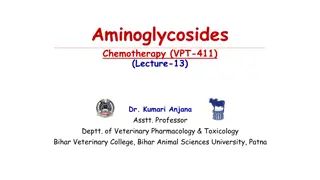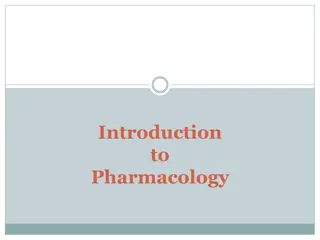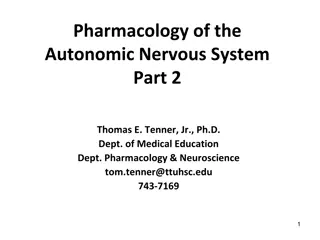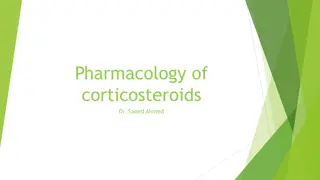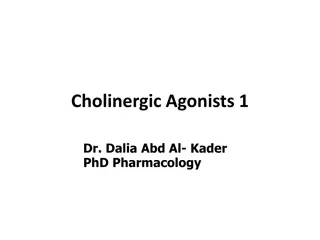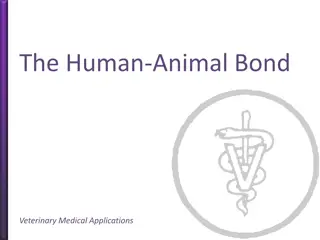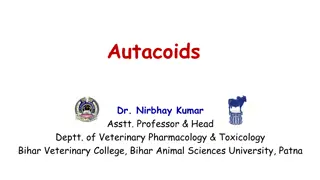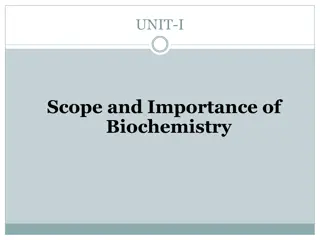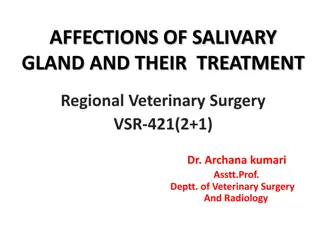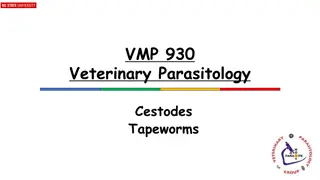Overview of Tranquillizer-Sedatives in Veterinary Pharmacology
Tranquillizer-sedatives are drugs used in veterinary medicine to reduce mental tension, induce calmness, and manage behavioral disorders in animals. The chapter covers the classification, therapeutic uses, mechanisms of action, and adverse effects of various tranquillizer groups such as phenothiazines, benzodiazepines, and butyrophenones. Phenothiazine derivatives, in particular, are widely employed for chemical restraint and behavior management in animals.
Download Presentation

Please find below an Image/Link to download the presentation.
The content on the website is provided AS IS for your information and personal use only. It may not be sold, licensed, or shared on other websites without obtaining consent from the author. Download presentation by click this link. If you encounter any issues during the download, it is possible that the publisher has removed the file from their server.
E N D
Presentation Transcript
TRANQUILLIZER-SEDATIVES/TRANQUILIZERS Dr.Kumari Anjana Assistant Professor Deptt. of Veterinary Pharmacology & Toxicology Bihar Veterinary College, Bihar Animal Sciences University, Patna
Overview of the chapter Introduction to Tranquillizer-sedatives Classification of Tranquillizer-sedative Therapeutic uses Mechanism of Action : Phenothiazine tranquillizer Pharmacological effect Adverse effects of chlorpromazine Butyrophenon Derivatives Benzodiazepine Derivatives Rauwolfia Derivatives
TRANQUILLIZER-SEDATIVES/TRANQUILIZERS Tranquillizers: is a drug which reduces mental tension and produces calmness without inducing sleep. Drugs that produces calmness in an agitated patients and reduces anxiety without producing sedation or affecting consciousness. Also termed as peace pills. Ataractics, Psycholeptics or neuroleptics. Tranquillizers: Antipsychotic drugs or MajorTranquillizers Anxiolytics or MinorTranquillizers
In the 1950s phenothiazine derivatives and reserpine were introduced into clinical veterinary medicine and were referred to as ataractics or tranquillizers. These are called also neuroleptics or antipsychotic drugs in human medicine because of their primary effect on psychic (mental processes). In man, these agents are used primarily for the treatment of psychiatric disorders (e.g., schizophrenia), while in animals their principle use is in the chemical restraint for various diagnostic procedures and also in the treatment of some behavioural disorders.
Antipsychotic drugs Classification: Phenothiazines- chlorpromazine, promazine, Triflupromazine Acepromazine, Thioxanthins- choprothixene Benzodiazepines- Diazepam, lorazepam, oxazepzm, temazepam, nitrazepam, chlodiazepoxide, flurazepam, chlonazepam, midazolam, zolpidem. Butyrophenones- Azaperone, Droperidol Rauwolfia derivatives: Metoserpate hydrochloride
Phenothiazine derivatives Phenothiazine derivatives are tranquillizers or neuroleptics, which have been used in humans to treat a variety of psychotic disorders. In veterinary medicine, they are used primarily for chemical restraint. These are widely used to restrain refractory animals during examination or transportation, and to prevent animals from licking wounds or chewing bandages and splints. Although phenothiazines may reduce an animal's response to conditioned stimuli.
Phenothiazine derivatives have a three ring structure in which two benzene ring are linked by a sulphur and a nitrogen atom. Substitution on the ring structures are made at positions C2 and N1O. Depending on the substitution at N10, there are three classes of phenothiazine's: Aliphatic side chain or the dialkyl amine group: e.g. Chlorpromazine, trifluopromazine acepromazine, promazine etc. Piperidine side chain: e.g. Mepazine, thioridazine, mesoridazine, pipracetrazine etc. Piperazine side chain : e.g. Prochlorperazine, trifluperazine, fluphenazine, thioproperazine, butaperazine etc. Fig : . Phenothiazine thioethylperazine,
Structure activity relationship of Phenothiazine : Substitution at C2 position produces: More active compounds than elsewhere in the ring. Compounds with substitution by CF3 at C2 are more active than Cl substitution at C2. Any substitution other than F or Cl at C2 does not change potency over the non substituent group. Substitution at N1O by : Aliphatic side chain yields compounds which are least potent; Piperidine ring yields little more active and potent The piperazine ring substitutes are the most potent of all the derivatives of phenothiazine's. Piperidine side chain produces: Lower extrapyramidal symptoms or syndrome like rigidity, Akinesia and tremors etc. Piperazine side chain produces: More intense ketatonia or flaccid type of paralysis, More potent antiemetic effect, Less tendency to produce sedation and autonomic effects such as hypotension etc.
Mechanism of Action Phenothiazines are tranquillizer-sedatives that have a wide range of activity arising from their depressant effects on the CNS and on various central neurotransmitters receptors. While the exact mechanism of action is not fully understood, the phenothiazines have potent action on dopamine receptor, especially D2-dopamine receptor blocking action. The phenothiazines mainly block postsynaptic dopamine receptors in the CNS and may also inhibit synthesis and/or release of dopamine through D2-receptors located pre-synaptically.
They are thought to depress portions of the reticular activating system that assists in control of body temperature, basal metabolic rate, emesis, vasomotor tone, hormonal balance, and alertness. Dopaminergic receptors in the basal ganglia appear to cause the extrapyramidal symptoms, while those in the chemoreceptor trigger zone (CTZ) are responsible for antiemetic action. They exert a sedative action by depressing the brain stem and the connections to cerebral cortex.
Additionally, phenothiazines have varying degree of alpha-adrenoceptor, muscarinic receptor, 5-HT receptor and histamine- receptor blocking activities. Theses effect may supplement to their pharmacological effects and/ or determine side effect profile. They also antagonize central stimulant action of sympathomimetics, but not the convulsions caused by strychnine or picrotocin (CNS stimulants) and morphine excitation in cats. Phenothiazine tranquilizers should not use for control of epileptic seizures (lower seizure threshold).
Pharmacological effect Central nervous system Sedation: Chlorpromazine in animals produces mild to moderate sedation. The sedative effect of chlorpromazine differs from that of barbiturates since it does not appreciably affect motor responses of the animal and also does not produce drowsiness. Its effect is variable and may be unpredictable. Aggressive tendency of animals is strongly inhibited by chlorpromazine.
Behavioural effects Chlorpromazine and other phenothiazines, may decreases spontaneous motor activity in animals. At high doses, cataleptic effects may be produced so animals may remain immobile in a fixed position for long periods, though they may still respond to stimulation. Chlorpromazine particularly active in suppressing conditioned avoidance responses. Various forms of stereotyped behavior in and mice induced by amphetamine are strongly inhibited by chlorpromazine.
Antiemetic effects Chlorpromazine is effective in antagonising apomorphine induced emesis in dogs, but not in cats. The antiemetic effect is related to its selective depression of the emetic centre CTZ located in the brain stem. Chlorpromazine also has antihistaminic and antimuscarinic activities, which may assist in controlling vomiting.
Endocrine effects: At high doses, chlorpromazine appears to block the release of follicle-stimulating hormone (FSH) and luteinizing hormone (LH). Ovulation is blocked and oestrous cycle is suppressed. Chlorpromazine increases plasma prolactin concentration through inhibition of D2 dopamine receptors (Dopamine acts physiologically as an inhibitor of prolactin secretion; inhibition of dopamine receptor causes enhanced prolactin secretion). An increase in plasma prolactin concentration can result in galactorrhoea. Other endocrine effects include inhibition of release of melanocyte stimulating hormone (MSH). Temperature: Chlorpromazine produces hypothermia in treated animals through depletion of catecholamine' in hypothalamus.
Other effects Chlorpromazine and other Phenothiazine block a variety of receptors including cholinergic-muscarinic, H1-histaminic, alpha-adrenergic, and 5- hydroxytryptaminergic receptors. Blocking of muscarinic receptor produces a variety of peripheral effects including blurring of vision, dry mouth and eyes, constipation, and urinary retention. Alphal - adrenergic receptor blocking action results in orthostatic hypotension. Vasomotor activity controlled via the hypothalamus or at the medullary level is depressed by chlorpromazine. Chlorpromazine also has a direct effect on the myocardium and can reduce contractility and cause arrhythmias.
Important side effect of chlorpromazine Important side/ adverse effects of chlorpromazine include fall in blood pressure, hypothermia, protrusion thrombocytopenia, platelet dysfunction, and ataxia. Chlorpromazine produces extrapyramidal symptoms in cats in high doses, which are characterized by tremors, shivering, diarrhea and loss of righting reflex. of nictitating membrane, Lethargy, diarrhoea, and loss of anal sphincter tone may also be seen. Cardiovascular collapse, secondary to bradycardia and hypotension, has been reported in all major species. Dogs, particularly Boxer breed, are more sensitive to these effects than other species.
Doses and Route of Administration Phenothiazine Tranquilizers Chlorpromazine: Dog: Sedative or tranquilizer 0.5-4 mg/kg IV or 1-5 mg/kg IM Cat 1-2 mg/kg IM or SC Pig: 0.5-4.5 mg/kg IM Cattle as preanaesthetic @ 0.2 mg/ kg 1M
Thioxanthine Derivatives Pharmacological effects similar to phenothiazine derivatives (blockade of D1 (+) and D2 (+++) receptor in CNS. Chloprothixene: Has antiemetic and antihistaminic effects. Its sedative and tranquilizer doses are: Dog- 4 mg/kg 1M or IV; Small livestock: 0.5 mg/kg IV.
Butyrophenon Derivatives Butyrophenontranquillizers or neuroleptics are commonly used in veterinary medicine for sedation and chemical restraint. They probably act through similar central mechanism to the phenothiazine sand chemically there are similarities. These drugs block motor activity, suppress the adverse effects of stress and trauma and have antiemetic effect. Their action is through antagonism of dopamine through blockade of D1 (+) and D2 (+++) receptors in CNS. These drugs also exert peripheral adrenergic blockade. At equi-effective dose rates, butyrophenones generally possess fewer side effects, particularly the antiadrenergic and antihistaminic effects, than the phenothiazine s. Examples of butyrophenon derivatives -- Azaperone, Droperidol
Azaperone It is extensively used in pigs, for pigs it is considered as sedatives of choice.
Droperidol: It is a butyrophenone that is usually combined with fentanyl citrate for use in dogs. When used together, droperidol-fentanyl induces considerable neuroleptanalgesia. Droperidol as a tranquillizer-sedative is about 400 and 3000 times more potent than chlorpromazine and promazine in dogs, respectively. It is about 1000 times more active than chlorpromazine and chlorprothixene as an antiemetic. Its cataleptic immobility potential also is several times higher than chlorpromazine and chlorprothixene. Droperidol and chlorprothixene are among the most potent antitraumatic shock agents. In dogs, dr peridol has high margin of safety as its potential adverse effects (e.g., tremors, muscle spasticity and hyperirritability) occur only after IV administration and at high doses.
Rauwolfia Derivatives Reserpine is the alkaloid obtained from the roots of an Indian medicinal plant Rauwolfia serpentina. It is used as a tranquilizer and as an antihypertensive drug in man. In veterinary practice other tranquilizers are preferred to reserpine. Metoserpate HCI Synthetic analog of reserpine. It is used as tranquilizer for flock treatment of birds It is used as @ 568.5 mg/3.8 litres of drinking water or at 150 ppm level in feed.
Benzodiazepine Derivatives These drugs exert central depression ranging from sedation through hypnosis to anticonvulsant effect and relaxation of skeletal muscles. MOA: facilitating the opening of GABA-activated chloride channels. These drugs have no significant effect on cardiovascular and respiratory system at sedative or tranquilizer doses. The most commonly drug under this group is---Benzodiazepines- Diazepam, lorazepam, flurazepam, chlonazepam, midazolam, oxazepzm, temazepam, nitrazepam, zolpidem.
Therapeutic uses of Tranquillizers As preanaesthetic sedatives for smooth induction of anaesthesia and reduce the dose of anaesthetic. To calm or quieten an excited animal for clinical examination. To relive the stress of transport or vomition (motion sickness).










